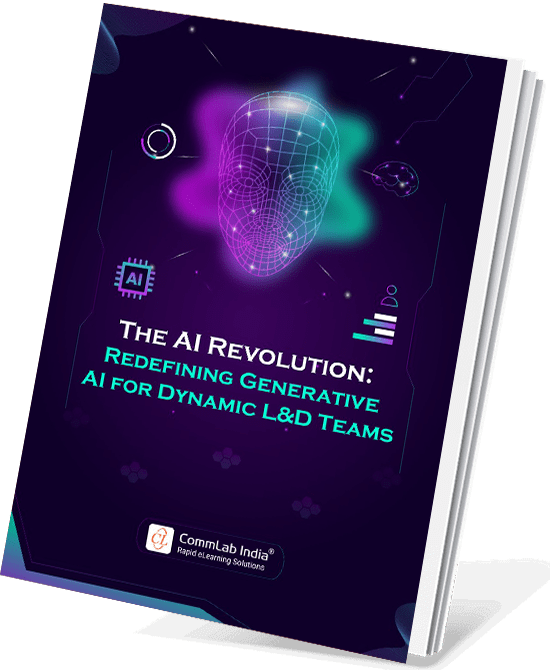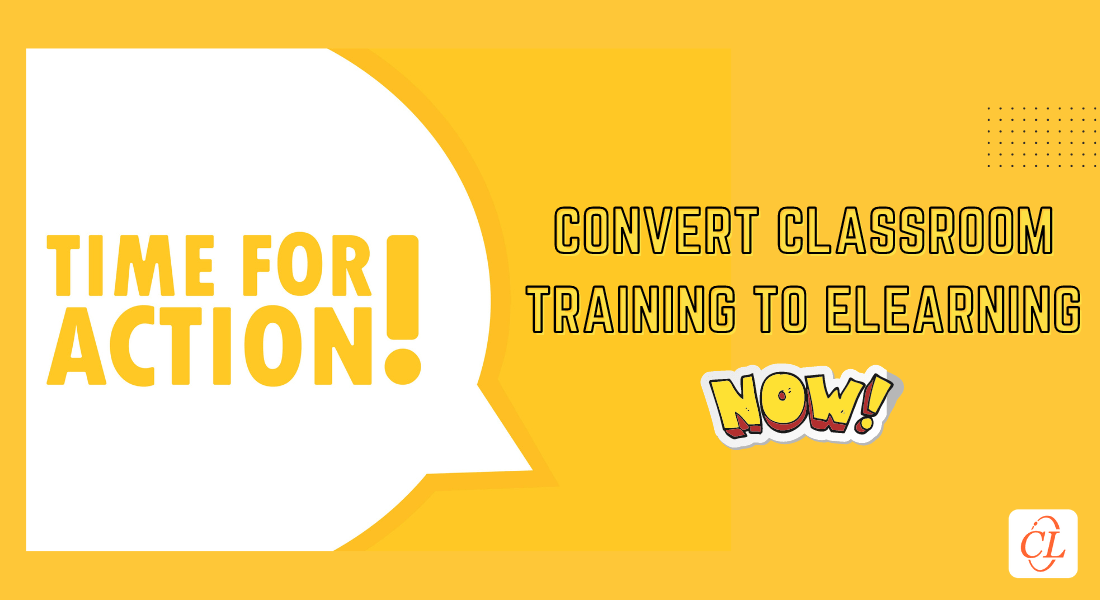How Can Custom eLearning Impact Corporate Training?

From basic necessities to unthought-of luxuries, today's world is full of options! And the world of corporate training is no different. It includes a variety of methods that can be used to facilitate impactful, engaging, and high-quality training for employees. One option that is making it to the spotlight is custom eLearning. Have you ever thought of giving it a try for your training initiatives and wondered how it can impact your corporate training? The wait is over. In this blog, we'll demystify the impact of custom eLearning in corporate training step-by-step. We'll start by understanding the concept of custom eLearning, the different challenges faced by organizations in corporate training, and how custom eLearning helps organizations tackle these challenges with the help of custom eLearning. Lastly, we'll take a look at the best practices for curating effective custom eLearning solutions for maximum productivity and training ROI. So without much delay, let’s begin!
→ Download eBook: Impact of Generative AI on L&D Teams
Table of Contents
- What Are the Corporate Training Challenges Faced by Organizations?
- What Is Custom eLearning?
- Why Are Custom eLearning Solutions Better than Off-the-shelf Courses?
- How Can Custom eLearning Impact Corporate Training?
- What Are the Upcoming Trends in Custom eLearning?
What Are the Corporate Training Challenges Faced by Organizations?

Uninterested Learners
One of the primary challenges faced by organizations trying to deliver effective in corporate training is maintaining learner engagement. Employees may be distracted by personal or work-related matters, leading to a lack of focus during training sessions. Moreover, if training is perceived as a mandatory requirement rather than an opportunity for growth, employees may approach it with a negative attitude. In addition to all this, busy schedules and competing priorities also make it difficult for employees to allocate time for corporate training or pursue it wholeheartedly.
Cost Constraints
The cost of designing and developing training solutions can be substantial. It may include bringing in external subject matter experts (SMEs) and video editors, investing in specialized eLearning authoring tools and AI tools, etc. For small businesses that have limited corporate training budgets, allocating funds for such resources can be a challenge. To add to the misery, generic corporate training programs may not even be able to fully address the specific learning needs and challenges of the organization. This potential mismatch between the training content and the organization's goals is a challenge that negatively impacts the overall training ROI.
Lack of Resources
Lack of resources can hinder the effectiveness of corporate training programs. Companies may not have the necessary expertise or resources to deliver high-quality training to the employees which is as good as no training. Moreover, as seen in the last point, costs associated with training materials, technology, and personnel can further strain resources.

Redefining Generative AI for Dynamic L&D Teams
Discover how Generative AI is breaking boundaries and empowering L&D Teams
- Why leverage Generative AI for L&D?
- What training managers should know about generative AI
- Ethical conundrums for Generative AI: Use cases
- Future prospects of Generative AI
Measuring Effectiveness of Training Program
Assessing the effectiveness of corporate training initiatives can be challenging. Relying solely on one-size-fits-all question banks for creating subjective assessments may not offer a comprehensive understanding of the training's influence on employee performance and business results. Without proper data collection and analysis, quantifying the return on investment (ROI) of training initiatives can prove to be challenging.
Difficulty Training the Remote Workforce
Remote work is the new norm! While organizations have been receptive to this idea, the shift toward remote work has introduced new challenges for corporate training. To begin with, if organizations continue with classroom training methods, the remote workforce will miss out on training.
And if they decide to tread the digital path for corporate training, technical difficulties such as poor internet connectivity, inadequate equipment, and software compatibility issues can disrupt training sessions. Moreover, maintaining employee engagement in a remote setting can be more difficult due to the lack of face-to-face interaction. In addition to all these challenges, fostering collaboration and knowledge sharing among employees can be quite difficult for remote teams.
Outdated Content
With the world (in general and business) changing at lightning speed, even the most recent content can become outdated quickly. Therefore, companies are constantly challenged on this front. They need to ensure that the training materials stay relevant and up-to-date. However, creating the entire eLearning course to accommodate the latest industry changes can be cumbersome (and costly).
To tackle all these situations effectively, custom eLearning offers a ray of hope. So let’s dig deeper into it!
What is Custom eLearning?
As the name suggests, custom eLearning refers to tailored corporate training solutions. They are designed to meet the specific learning needs of employees and the organization, resulting in growth and success. Custom eLearning solutions are different from off-the-shelf eLearning courses. Here’s how.

If I have to explain with the help of an example, then think of custom eLearning as a suit that is crafted to fit you perfectly! It’s not something that’s lying there on the shelf and you have to try different sizes before finding the perfect fit. Instead, everything is curated as per your demands and preferences.

Redefining Generative AI for Dynamic L&D Teams
Discover how Generative AI is breaking boundaries and empowering L&D Teams
- Why leverage Generative AI for L&D?
- What training managers should know about generative AI
- Ethical conundrums for Generative AI: Use cases
- Future prospects of Generative AI
Why Are Custom eLearning Solutions Better than Off-the-shelf Courses?
While off-the-shelf eLearning courses might provide a quick fix for some training needs, it lacks the depth and relevance that custom eLearning solutions offer. Traditional training methods, such as in-person workshops and seminars, are often rigid, expensive, and difficult to scale. Custom eLearning solutions, on the other hand, are flexible, cost-effective, and scalable, making them an ideal choice for modern corporate training.
How Can Custom eLearning Impact Corporate Training?
To keep the answer short and simple, custom eLearning can impact corporate training in a variety of positive ways. But I’m sure this doesn’t really satisfy the real quest for “how” or even convince you to give custom eLearning a try. Isn’t it? So in this section, we’ll explore in detail each and every benefit of custom eLearning that contributes to positive corporate training outcomes. Before we get started, here’s a quick overview of how custom eLearning impacts corporate training.
Custom eLearning Impacts Corporate Training Positively! Wondering how?
Here’s the answer:
- Ensures Alignment with Business Objectives
- Increases Learner Engagement
- Fosters Knowledge Retention
- Enables Cost-Effective Training
- Offers Scalability
- Supports Flexibility and Accessibility
- Provides Data-Driven Insights
Now that you have a basic idea, let’s take a look at each benefit in detail.
Ensure Alignment with Business Objectives
So the first (and important) positive impact of custom eLearning on corporate training is alignment with business objectives. Well, it’s obvious that the corporate training programs are designed keeping the organizational goals and employee learning needs in mind. But let’s face it. Not every off-the-shelf training content that you assign to your employees fits the bracket of being aligned with the organizational goals. Sometimes, a topic that your employees just need to touch upon might be explained a bit too much while the concept they really need to get handy with might fast forward. And if these go well, there might be a component, a perspective that doesn’t really convey what your company stands for. Finding the perfect off-the-shelf courses that align well with company goals and learner needs can be tough.
To avoid such situations, custom eLearning comes in handy. Here’s how.

Custom eLearning solutions focus on aligning training content directly with a company's specific business objectives. They are tailored to address the unique needs and goals of a business. For example, if a company aims to improve its customer service, custom eLearning can be designed to focus on developing employees' communication and problem-solving skills, directly contributing to that goal. By aligning training with these business objectives, employees can see a clear connection between their training and their roles, which increases learner engagement and motivation. They understand how their skills and knowledge are critical to the company's success, making the training more meaningful and effective.
Moreover, custom eLearning allows companies to update training content quickly as business objectives evolve. Whether the company intends to launch a new product, adopt new technologies, or make some changes in the company process, custom eLearning modules can be modified according to them, thus keeping employees' skills relevant and aligned with the latest business needs.

Therefore, custom eLearning has a positive impact on corporate helps create a more focused, efficient, and effective training program that supports the company’s growth and performance goals. It empowers employees with the right skills and knowledge, ensuring that everyone is working towards the same objectives, which ultimately drives the organization’s success.
Increase Learner Engagement
In a world full of distractions, only a few are able to master the art of grabbing attention. Are your instructional designers one of them? You see, grabbing the attention of the learner is the first (and most important) step in achieving the final outcome. No matter how good the content is or which famous personality created it, if the learners aren’t paying attention, it’s not worth it. Because at the end of the day, it’s going to be them who turn theory into practical, thus delivering results. So if the learners are not paying attention only, engaging them in the training process is a far-fetched dream. Then what can you do?
While learner engagement is a major missing in catalog courses, custom eLearning nails this trait. Not just learner engagement, custom eLearning also ensures interactivity in the learning process. By maintaining these two essential factors of effective learning, custom eLearning courses have a positive impact on corporate training. Wondering how? Let’s understand. When employees are more engaged in their training, they are more likely to retain information and apply it to their work. This leads to better job performance and satisfaction.

Redefining Generative AI for Dynamic L&D Teams
Discover how Generative AI is breaking boundaries and empowering L&D Teams
- Why leverage Generative AI for L&D?
- What training managers should know about generative AI
- Ethical conundrums for Generative AI: Use cases
- Future prospects of Generative AI
Now that we’ve established that custom eLearning increases learner engagement and interactivity, it’s time to zoom in and take a closer look at how custom eLearning is able to do so.
Custom eLearning boosts learner engagement by facilitating personalized learning. That’s right! Custom eLearning solutions allow organizations to create training modules that are specifically tailored to the needs, roles, and interests of their employees. This relevance makes the training more interesting and meaningful for learners.
For example, a customer service team training through interactive scenarios that simulate real-life customer interactions will yield a better learner response in contrast to some generic courses covering tips on how to interact with customers. Similarly, curating custom eLearning on cybersecurity protocols for IT staff results in higher engagement. Training materials that directly relate to the daily tasks and challenges of employees increase engagement and motivate learners to participate and learn.
Interactivity is another key aspect of custom eLearning that complements learner engagement. Traditional training methods, such as lectures or slide presentations, can be passive and monotonous, leading to disengagement. In contrast, custom eLearning offers a great scope to incorporate a variety of interactive elements. eLearning interactivities require active participation, keeping learners involved and attentive.

Apart from personalized learning and interactivity, multimedia components, too, play a major role in helping custom eLearning foster learner engagement. Reading blocks of text is nothing but a mantra for boredom and disengagement. Therefore, custom eLearning content includes multimedia components that cater to different learning styles and make the content more visually appealing. This multimodal approach not only keeps learners interested but also helps reinforce key concepts, making the training more effective.

Foster Knowledge Retention
Despite their best efforts, it can be difficult for employees to recall information that was provided during the training sessions. It becomes even more difficult when they are constantly bombarded with a variety of new information at other (most recent) times. Then you must be wondering why to conduct training at all. Isn’t it? But training is crucial for employee and organizational growth. The important thing here is to focus on providing training in a way that maximizes knowledge retention among the learners. After all, retaining knowledge is essential for employees to effectively apply what they've learned to their daily tasks, leading to improved performance and productivity.
This is where custom eLearning comes into the picture. It fosters knowledge retention by combining different aspects like personalized learning experiences, relevance, interactivity, and flexibility.

By tailoring content to the specific needs, roles, and learning styles of employees, custom eLearning solutions ensure that the training is relevant as well as directly applicable to the daily work of the employees. When employees can see the immediate relevance of what they are learning, they are more likely to pay attention and remember the information.
Another factor that boosts knowledge retention in custom eLearning is the use of interactive elements. Engaging learners with quizzes, eLearning simulations, and real-life scenarios requires active participation, which has been proven to aid memory and result in better knowledge retention. For instance, an employee who completes a simulation of a complex sales negotiation is more likely to remember and apply those skills than if they had just read about negotiation strategies. Interactive content not only keeps learners engaged but also reinforces learning by allowing them to practice and apply new skills in a safe environment.
Enable Cost-Effective Training
At times, the difference between L&D initiatives and their success is BUDGET! That’s right. Cost can be a major hindrance in the way of delivering high-impact, top-quality corporate training. But with custom eLearning, you don’t have to worry about the budget constraints. Compared to traditional training methods, it offers a cost-effective solution to corporate training.

Custom eLearning significantly reduces the costs associated with travel, accommodation, and venue expenses. As employees can access the training content from their computers or mobile devices, they don't need to worry about traveling to attend the training sessions. This is especially helpful for companies with employees in different locations, where travel costs can quickly add up.
Custom eLearning also eliminates the need for printed materials and physical resources. Moreover, training content is delivered digitally. This makes it easier for organizations to update and distribute the training material without incurring additional printing or distribution costs. It not only saves money but also ensures that employees always have access to the most current and relevant information.
Offer Scalability
Expansion ventures are good and exciting for businesses, right? But do you think the same holds true for the training aspect as well? If we consider conventional classroom training, it means more cost and scheduling challenges. However, custom eLearning allows companies to train large numbers of employees simultaneously without increasing costs.
Once a custom eLearning module is developed, it can be reused and updated as needed, providing a long-term, cost-effective training solution. This scalability makes it easier to onboard new employees, roll out training for new products, or update compliance training without the need for recurring expenditures.
Support Flexibility and Accessibility
Unlike traditional classroom-based training that has rigid schedules and physical attendance as its foundation, custom eLearning courses can be accessed anytime, anywhere, at the learner's convenience. This flexibility empowers employees to learn at their own pace, accommodating different work schedules and personal commitments.
Along with flexibility, accessibility is another great benefit offered by custom eLearning to ensure effective corporate training. Custom eLearning solutions leverage technology to create and deliver training courses. Given the digital nature of today’s world, custom eLearning courses can be made available to a wider range of employees, regardless of their location or physical limitations.

For example, employees working remotely can access courses from their own devices, and those with disabilities can benefit from features like closed captioning, screen readers, adjustable text sizes, etc. This inclusive approach to training helps to bridge the gap between different employee groups and ensures that everyone has equal opportunities for professional development.
Provide Data-Driven Insights
An organization can stand to benefit immensely from well-designed and properly executed custom eLearning solutions. Wondering how? Well, of course through better learner engagement and higher retention rates. But most importantly, through data and insights into the training effectiveness. L&D teams can use the data gathered through custom eLearning modules to gauge different aspects of training and improve their corporate training programs.
The standout feature of custom eLearning is that it enables trainers to track learner progress and test scores in real time. They can monitor metrics such as completion rates, time spent on specific modules, and eLearning assessment scores and identify areas where learners may be struggling or losing interest. Based on this information, they can make adjustments to the instructional methods or content of the training program. Moreover, they can provide additional resources to help learners gain a better understanding of concepts.
Data-driven insights from custom eLearning can also help organizations measure the return on investment (ROI) of their training programs. By tracking metrics such as employee performance, productivity, and customer satisfaction, organizations can quantify the benefits of training and justify the costs associated with it. This information can be used to secure funding for future training initiatives and demonstrate the value of investing in employee development.
What Are the Upcoming Trends in Custom eLearning?
Now that you’ve seen how custom eLearning works like a charm to support and improve your corporate training outcomes, there’s a lot more that’s brewing in the world of custom eLearning solutions. Watch this video to learn about the various upcoming trends in custom eLearning so you can curate impactful training courses and stay ahead of your competitors.
Wrapping It Up!
So next time the question, “How can custom eLearning impact corporate training?” pops into your head, remember the benefits shared in this blog. There’s no second-guessing that custom eLearning is the present and future of impactful, result-driven training initiatives. But as the business world and technology are changing quickly, combining your custom eLearning efforts with artificial intelligence (AI) is highly recommended. AI holds immense potential to level up your custom eLearning solutions and maximize the training ROI. Wish to know more about AI in the L & D scenario? Well, we’ve curated just the right resource for you. Check out our eBook takes a deeper dive into the AI revolution for L&D teams. Download now!





